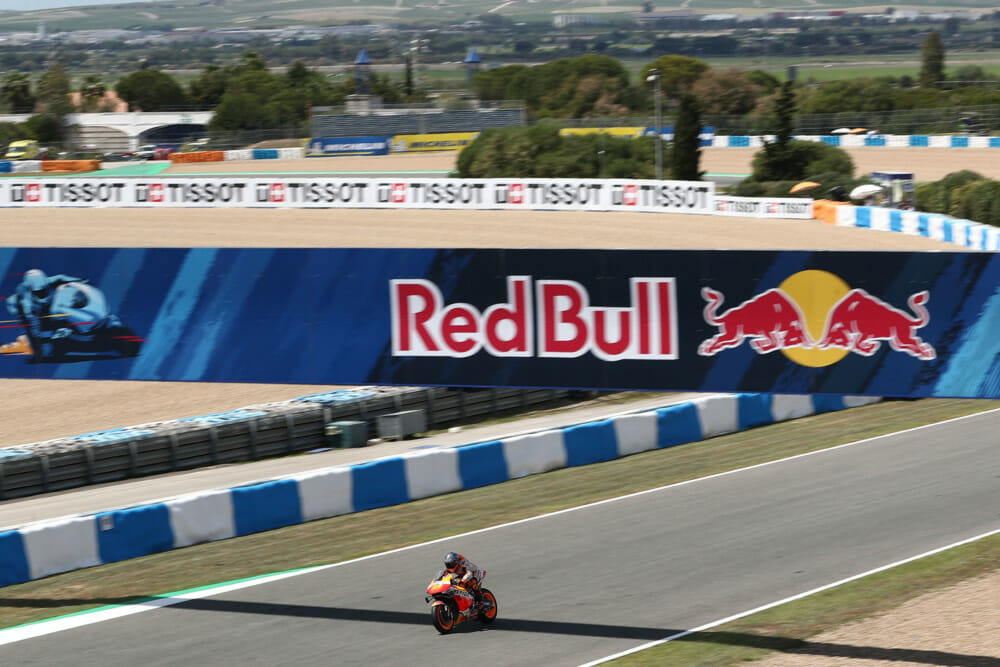Michael Scott | May 11, 2021
Cycle News In The Paddock
COLUMN
Too Fast? Too Close? Or Just Right?
The point of racing—entertainment and hedonism aside—must be to seek and find continual improvement, to further the development of motorcycle engineering.
To put it another way, to go faster.
An ambition that has, over the years, continued to be achieved, sometimes in leaps and bounds, sometimes with patient progress. But always forward. Mechanical, electronic and financial dumb downs notwithstanding, lap times continue to drop and top speeds to rise. For example, Zarco’s and Ducati’s record 225.2 mph set in March at Losail is likely to tumble in a couple of weeks at Mugello.
But when does it become too much?
The question is not entirely frivolous. Racing in 2021 has raised concerns in several diverse areas.
The first disquiet came in the opening rounds in Losail, with record-close top-15 in MotoGP (just over 8.9 seconds), and at least one lucky escape from high-speed disaster, when Jack Miller and Joan Mir twice clashed at speed. This peril was heavily underlined by Moto3’s pack of 20 or more crawling over one another, after a rear-end collision at close to top speed. Rodrigo’s brake protector snapped off, but, mercifully, it narrowly did its job. Had he looped over the handlebars at the front of the jostle, the consequences would have been life-threatening for a number of teenagers yet to reach voting age.
There was more at the last round at Jerez.
 A number of big crashes have put safety into the spotlight at Jerez.
A number of big crashes have put safety into the spotlight at Jerez.
One aspect was headlined by Marc Marquez barreling into the air-fence at turn seven. This is an unusual place for a crash. Last year, over two weekends of racing, there was just one fall recorded there. This year, there were five in a single weekend, and all were violent. One of them, in Moto2 warm-up, sent Vietti’s bike right over the air-fence.
They revealed a hitherto ignorable fact. The barrier may be air-fenced, but it is a lot too close for comfort, and this is a result of the faster speeds.
Jerez joined the calendar in 1987, and winner Wayne Gardner’s Honda NSR500’s lap record was at 84.9 mph. In 2021 his son Remy set Moto2 pole at 98.2 mph. And that in just the intermediate class. In MotoGP, Vinales’s new record was 102.4 mph. The bikes are going more than 20 percent faster. The run-off areas are the same.
Then Quartararo—robbed of a dominant win by arm-pump. This was hardly a one-off. Most striking is just how common this complaint has become. Just this year, after the first races, Jack Miller and Jorge Martin had the op—a slash of the enclosing fascia membrane. Scarred forearms from corrective surgery are everywhere in the paddock—something of a badge of honor, or at least evidence of having passed an uncomfortable initiation ceremony.
Arm pump is a temporary problem: overworked muscles swell up within the enclosing fascia membrane, causing pain and enfeeblement, which subside after less than 30 minutes rest. It can be prevented by simple surgery cutting a lengthways slit in the fascia, though (as in Quartararo’s case) this can heal, requiring a repeat. Carpal tunnel syndrome, afflicting the tendons, is rather harder to deal with.
Both were once a rarity. The growing prevalence is easily explained. Tires that grip harder and brakes squeeze better (currently offering some 2G of deceleration). This imposes great strain on arm muscles which, with today’s sophisticated advanced riding techniques, combine precise throttle use at the same time as heavy braking and steering effort.
These problems are all more or less solvable. Well, not so much the close racing. Social distancing is never going to catch on there.
But speeds can be reduced and tire grip cut. It’s all a matter of regulation. Maximum permissible power outputs, and a control tire manufacturer sourced from the local budget tire shop, with a maximum allowable coefficient of friction.
Easier still, with wet racing slower and thus safer, permanent irrigation systems to be installed on all tracks. Be something of an extra expense in the desert of Doha, but then the Qataris have never minded spending money. Love doing so, actually.
Then there’s always the possibility of adding chicanes. If not speed humps as well.
But this is getting silly. Even sillier than the spectacle of the MotoGP Stewards Panel trying to stop Moto3 riders from maneuvering for slipstreaming in qualifying. (Talk about herding cats.)
Better to accept the progress and exult in it. And to live with the frisson of fear that accompanies one on the sofa, watching a tooth-and-nail race.
Because in the end, using the body count as the ultimate criterion, racing is much safer now than back in the old days, when it was a whole lot slower, but you could count on at least a handful of riders not making it through the year. CN
Click here for all the latest MotoGP news.